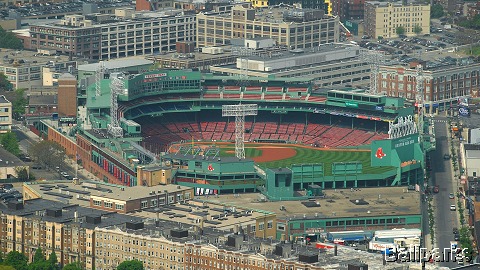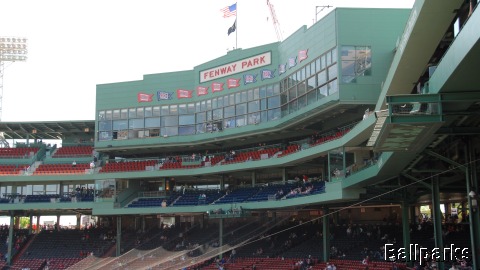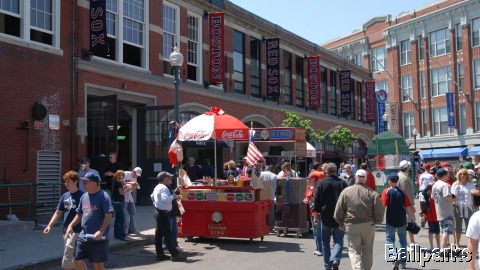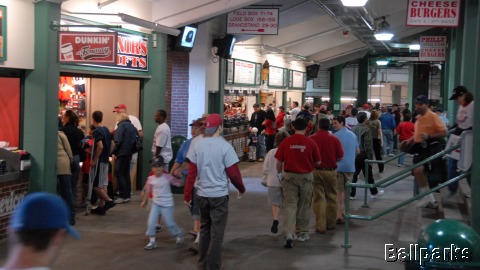Fenway Park
Boston, MassachusettsTenant: Boston Red Sox (AL) Architect: Osborn Engineering (1912 & 1934) Boston Red Sox tickets:
Capacity: 35,000 (1912); 35,500 (1947); 35,200 (1949); 34,824 (1953); 34,819 (1958); 33,368 (1960); 33,357 (1961); 33,524 (1965); 33,375 (1968); 33,379 (1971); 33,437 (1976); 33,513 (1977); 33,538 (1979); 33,536 (1981); 33,465 (1983); 33,583 (1985); 34,182 (1989); 34,171 (1991); 33,925 (1992); 34,218 (1993); 33,577 for day games and 33,993 for night games (2001); 36,298 (2004); 37,654 (2006); 38,805 (2007); 39,605 (2008). Fenway Park attendance figures Location: Left field (N), Lansdowne Street, Boston & Albany Railroad tracks and Massachusetts Turnpike (I-90); third base (W), Brookline Avenue and Jersey Street (renamed Yawkey Way after BoSox owner in 1976), also bowling alley building attached to park; first base (S), Van Ness Street (built after park was done); right field (E), Ipswich Street and Fenway Garage building. Dimensions: Left field: 324 (1921), 320.5 (1926), 320 (1930), 318 (1931), 320 (1933), 312 (1934), 315 (1936) [figure revised to 310 in 1995]; left-center: 379 (1934); deep left-center at flagpole: 388 (1934); flagpole removed from field of play (1970); center field: 488 (1922), 468 (1930), 388.67 (1934), 389.67 (1954), 390 (current); deepest corner, just right of center: 550 (1922), 593 (1931), 420 (1934) [Note: 593 is cited in 1931-1933 Bluebooks; this could be a misprint.] right-center, just right of deepest corner where the bullpen begins: 380 (1938), 383 (1955); right of right-center: 405 (1939), 382 (1940), 381 (1942), 380 (1943); right field: 313.5 (1921), 358.5 (1926), 358 (1930), 325 (1931), 358 (1933), 334 (1934), 332 (1936), 322 (1938), 332 (1939), 304 (1940), 302 (1942); backstop: 68 (1912), 60 (1934); foul territory: smallest in the majors.
Fences: Left field: 25 (wood, 1912), 37.17 (tin over wood over concrete lower section, 1934), 37.17 (hard plastic, 1976); left-field wall to center bleacher wall behind flagpole: 18 sloping to 17 (concrete, 1934), crash pad added from 18 inches to 6 feet on left and center field walls (1976); center field to bullpen fence: 8.75 (wood, 1940); right-center bullpen fence: 5.25 (wood, 1940); right-field wall and railing: bullpen 3.42 sloping to 5.37 at foul pole (steel, 1940); right-field belly: the low railing and wall curve out sharply from the 302 marker at the right-field foul pole into deep right field. The first two games at Fenway Park were rained out, so the new ballpark opened on April 20, 1912. That was the same day as the opening of Detroit's Navin Field, later known as Tiger Stadium, and just five days after the sinking of the Titanic. The 35,000 seat ballpark was built in the Fenway section of Boston, an area known for its many fens, or marshes. The Red Sox fit 47,627 people into Fenway for a September 22, 1935 doubleheader against the New York Yankees. Fire laws in the 1940's ended that type of overcrowding and the biggest postwar crowd was 36,388 for a game against the Cleveland Indians in 1978. Fenway's clubhouses are small and modest. The tunnels which lead to the dugouts are usually wet, and the floorboards creak. Like most of baseball's other old parks, it's cramped and even a little bit uncomfortable. Those other old parks have disappeared, but Fenway is still there. Red Sox fans continue to crowd into Fenway's cozy confines, pushing the Red Sox average attendance to over 2.5 million into the 21st century. They've come to Fenway in great numbers ever since the park opened, back in the years when the Red Sox regularly appeared in the World Series. The Red Sox won the World Series at Fenway in the park's first year and won it three more times by 1918, but it took them another eight-six years before they won it again. Some have thought the Red Sox were cursed when they sold Babe Ruth to the Yankess after the 1919 season. For them, the curse was lifted in 2004.They won one of the most memorable game in World Series history, on October 21, 1975, when Carlton Fisk ended Game 6 against the Cincinnati Reds with a 12th-inning home run over the 37 foot tall Green Monster just inside the left field foul pole. It would have been a dramatic shot in any park, but hitting it over the Green Monster made it that much better. A 23-foot screen caught balls which cleared the wall until the Red Sox built seats atop it in 2003. The ladder once used to retrieve balls from the screen still remains. The Green Monster features a manually operated scoreboard that displays division standings, the line score for the game and scores from other MLB games. In Morse code down the side of the scoreboard are the initials of Thomas A. Yawkey and Jean R. Yawkey, who owned the Red Sox from 1933-93. The sign says the Green Monster is 310 feet from home plate. It's 304.779 feet, high according to one measurement or 308, according to another. It has been green only since 1947. Before that, Fenway's left-field wall was covered with advertisements. The original 25-foot wall was made of wood, which burned along with the rest of the park in a January 5, 1934, fire. The second, 37-foot wall was tin over wooden railroad ties. The current hard plastic wall, also 37 feet high, was erected in 1976.
The bullpens were moved from fair territory to right field in 1940, which made the right-field fence closer and, consequently, helped Red Sox star Ted Williams hit more home runs. The Red Sox became the third-to-last major league team to play home night games when lights went up at Fenway on June 13, 1947. A message board was installed above the center-field bleachers in 1976, and private suites were added to the roof in 1983. A glassed-in seating section called the 600 Club (renamed the .406 Club in 2002) was built behind home plate in 1988. The glass was removed and the section was renamed the EMC Club in 2006. Even with all those changes, Fenway still looks very much as it did decades ago. For many years, the roof over the grandstand in right featured retired Red Sox uniform numbers in the order they were retired: 9, 4, 1, and 8, eerily reminding us of Sept. 4, 1918, the day before the start of the last World Series the Red Sox would win for close to a century. However, the numbers have since been rearranged in numerical order, and now include Carlton Fisk's number 27, Johnny Pesky's number 6 and Jim Rice's number 14. Although the distance has never been posted on the wall, the right-field stands are only 302 feet from home plate at the foul pole. That foul pole was once nicknamed "Pesky's Pole." Red Sox pitcher Mel Parnell coined the term, after Pesky hit a home run just beyond the famous pole. That home run was one of only six homers Pesky ever hit at Fenway Park, and it won the game for Parnell. Although the roof over the grandstand in right seems to invite home runs, no one has ever hit one over it. The Red Sox haven't always been the only tenants at Fenway. The AFL's Boston Patriots played there from 1963-68 and the Boston Redskins (later the Washington Redskins) played there before that. The Boston Yanks and the Boston College and Boston University football teams played there, too. Fenway once hosted a World Series that did not include the Red Sox. The Boston Braves won the 1914 Series at Fenway because Braves Field was still under construction.
Fenway Facts:
The Red Sox proposed a replacement for Fenway Park in 1999. Several sites were proposed by the team for a new ballpark, but many individuals, as well as the city of Boston, expressed an interest in refurbishing Fenway Park. An organization called "Save Fenway Park!" was organized in 1998 to promote ways to preserve the old ballpark. On January 17, 2002, a day after a new Red Sox ownership group was approved, prospective club president Larry Lucchino announced plans to hire architect and urban planner Janet Marie Smith to oversee stadium issues in Boston. Smith played a major role in the design of Oriole Park at Camden Yards in Baltimore and Turner Field in Atlanta. This action began to fulfill the promise that the new owners made to preserve Fenway Park instead of building a new ballpark. The team has been gradually adding seats where they can, primarily on the roof down the base lines and, most notably, 274 seats above the "Green Monster" in left field. The team announced in September of 2004 that it would add as many as 2,000 seats to Fenway Park after the 2005 season. Although the team did not give any specifics, this would be a relatively major expansion. The team's principal owner, John Henry, said that a ballpark expansion would bring park capacity to no more than 40,000 fans. For the 2005 season, the Red Sox made some significant changes to Fenway Park. Gate E has been transformed into a grand entrance, with a new restaurant in the adjacent Jeano building. Landsdowne Street has been refurbished with cherry trees and historic street lamps. A new roomier concourse was added behind section 16 on the 1st base side. The old field was completely dug up and replaced with a new $2 million field, complete with state-of-the-art drainage and heating systems. These systems will mean fewer rainouts, and allow the grounds crew to prep the grass earlier in the spring and keep it later into the fall. Also, the old crown in the field, which was necessary for drainage, has been flattened, so the players sitting in the dugouts can see the feet of the outfielders. The Red Sox also expanded the team's clubhouse, adding a new weight room, batting cage, interview area, and physical training and therapy area.
More on Fenway Park:
Recommended Reading (bibliography):
Boston Red Sox Help us provide a better web site by completing our feedback form PHOTOGRAPHS: All photos © 2007 by Russ Andorka. Updated July 2009 Tickets to Red Sox spring training, Boston Red Sox, Red Sox Blue Jays, Red Sox Yankees, NCAA Basketball Tournament, College Football Bowl, NCAA Football, New England Patriots and Paul McCartney provided by Ticket Triangle. Thanks to Bryan Davis and David Nevard for their contributions. BALLPARKS © 1996-2025 by Munsey & Suppes.
|










